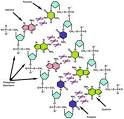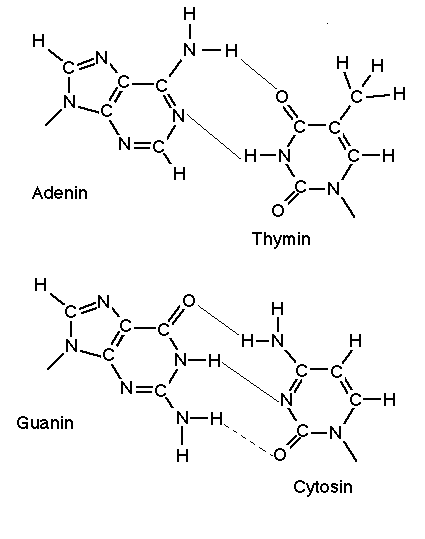Introduction
DNA is the abbreviated form of deoxyribonucleic acid which is a representation of the hereditary material of human beings as well as other living organisms (Russell, 2001, p.69). All living organisms contain the DNA material in their body make up. It is therefore the unique material that is used to differentiate people from others or even other creatures. For example, human beings will have a different genetic makeup from that of plants and animals.
In addition to this, human beings will have different genetic makeup from other human beings unless they are of the same family chain. The DNA serves as storage of the genetic information in the form of codes. DNA information is thus of great importance in several matters and issues facing all living creatures such as research, breeding, paternity tests among others. This paper is therefore an in-depth analysis of the DNA structure, components, how it works and importance.
The DNA Structure
The DNA is made up of two strands that are located in the nucleus of most cells. Some DNA strands can also be located in the mitochondria of the cells thus forming the mitochondrial DNA. The DNA structure was first invented not very long ago in the year 1953 by James Watson and Francis Crick (Russell, 2001, p.34). The two established that the structure of DNA can be well established by a right handed double helix. The double helix is thus made up of about ten nucleotide pairs on each turn of the helix. As mentioned above, the DNA is double helical thus one side contains a base while the other is a sugar phosphate backbone.
The two sides of the helical structure are connected by a hydrogen bond. The strands of the DNA are parallel to each other because they are arranged in opposite directions. The bases of the DNA strand pair up with each other in a bid to form the base pairs. The four DNA bases include Adenine, Thiamine, Cytosine and Guanine. Of these bases Adenine pairs up with Thymine while Cytosine with Guanine. Therefore a nucleotide is formed when the base, sugar and the phosphate join up together.
Properties of DNA
DNA has got many specific physical as well as chemical properties that facilitate its functioning (Calladine, 2003, p.96). For one, DNA is known to exist in pairs that have been intertwined to form a double helix shape. Secondly, DNA has a unique characteristic of replicating itself in the body such that new cells formed in the body have the same DNA strands as that of the existing cells. Thirdly, the DNA strand has the ability of coiling itself. Another significant feature of the DNA is that it has a pair or grooves that allow the interaction of bases and body proteins.
DNA Replication
The DNA replication is an important characteristic of DNA whereby the two strands of the intertwined double helix detach from each other then it attaches to another compliment base through the double bond. The DNA polymerase is the enzyme that is responsible for the combination of the phosphate and the nucleotide. As a result, a polynucleotide chain is formed whereby the nucleotides join to the old thus forming a new DNA strand. Other than replication, DNA strands also undergo transcription whereby the genetic information is transferred from the DNA to the RNA.
Functions and Uses of DNA
DNA is very important in body as it serves two essential functions in the body. The DNA is responsible for protein synthesis in the body thus enhancing the growth and development of the organism. The second important function is that of transferring the genetic material from the parents to its offspring. During the process of genetic transformation a messenger RNA (Ribonucleic acid) is used in the transfer the genetic material. The discovery of DNA has had a great contribution in the field of medicine as well as other sectors such as criminology (Rosalind Franklin University, 2004, p.1). DNA information is used widely in cloning, paternity tests, verification of crime, breeding, research just to mention but a few.
Conclusions
From the discussion above, it can be depicted that DNA is a very vital constituent of the body despite its minority. The discovery of DNA has been of great help to the society as it has helped in solving puzzles and cases that would remain unsolved were it not for DNA (Carina and Clayton, 2003, p. 154). The diagrams below show the figures and processes involved in DNA.
DNA Diagrams

This diagram represents the double helix shape of the DNA strands. It also shows hoe the bases are joined to each other on the strand through the hydrogen bond (Russell, 2001, p.32).

This is a DNA Molecule inside the nuclei of a cell. (Calladine, 2003, p.96)

The above figure show the Steps involved during DNA replication. (Russell, 2001, p.34)

These are the four Molecular components of the DNA molecule. (Russell, 2001, p.35)
Reference List
Calladine, C. (2003). Understanding DNA: the molecule & how it works. Amsterdam: Elsevier Academic Press.
Carina, D. and. Clayton, J. (2003). 50 years of DNA. Basingstoke: Palgrave Macmillan.
Rosalind Franklin University (2004). The Importance of DNA. Web.
Russell, P. (2001). Genetics. New York: Benjamin Cummings.